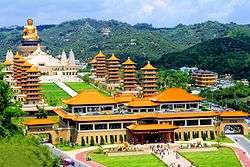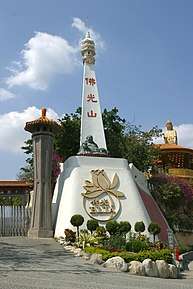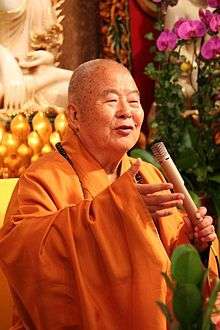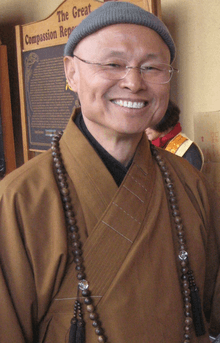Fo Guang Shan
Fo Guang Shan (FGS) (Chinese: 佛光山; pinyin: Fó guāng shān; lit.: 'Buddha's Light Mountain') is an international Chinese Mahāyāna Buddhist organization and monastic order based in Taiwan that practices Humanistic Buddhism. The headquarters, Fo Guang Shan Monastery is located in Dashu District, Kaohsiung, and is the largest Buddhist monastery in Taiwan. The organization is also one of the largest charity organizations in Taiwan. The organization's counterpart for laypeople is known as the Buddha's Light International Association.
佛光山 | |
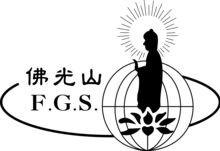 The Fo Guang Shan logo | |
| Established | 1967 |
|---|---|
| Founder | Hsing Yun |
| Type | Buddhist Monastic Order |
| Headquarters | Fo Guang Shan Monastery, Kaohsiung, Taiwan |
| Website | www |
| Fo Guang Shan | |||||||||||||
|---|---|---|---|---|---|---|---|---|---|---|---|---|---|
| Chinese | 佛光山 | ||||||||||||
| Literal meaning | Buddha's Light Mountain | ||||||||||||
| |||||||||||||
Founded in 1967 by Hsing Yun, the order promotes Humanistic Buddhism and is known for its efforts in the modernization of Chinese Buddhism. The order is famous for its use of technology and its temples are often furnished with the latest equipment.[1][2] Hsing Yun's stated position for Fo Guang Shan is that it is an "amalgam of all Eight Schools of Chinese Buddhism" (Chinese: 八宗兼弘; pinyin: bāzōng jiānhóng). The Fo Guang Shan order has an associated college, Fo Guang University, which offers undergraduate and postgraduate degrees in both Buddhist Studies and secular fields.
In Taiwan, Hsing Yun is popularly referred to as one of the "Four Heavenly Kings" and Fo Guang Shan is considered one of the "Four Great Mountains" or four major Buddhist organizations of Taiwanese Buddhism, along with Dharma Drum Mountain, Tzu Chi, and Chung Tai Shan.[3][4][5]
History
In 1967, Hsing Yun purchased more than 30 hectares in Dashu Township, Kaohsiung County as the site for the construction of a monastery. The groundbreaking ceremony was held on 16 May 1967.
Fo Guang Shan embarked on many construction projects, including university buildings, shrines, and a cemetery. In 1975, Fo Guang Shan's 36-metre tall statue of Amitābha Buddha was consecrated. In 1981, 15 years after its establishment, the Great Hero Hall was built. During these times, many other Fo Guang Shan temples outside the order's mother monastery were also built.
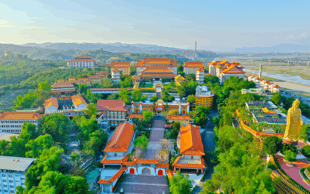
In May 1997, Hsing Yun announced that he would close the mountain gate of Fo Guang Shan to the general public. His reason in closing the monastery was to give monastics the cloistered atmosphere they need for their Buddhist practice. In practice, many Chinese monasteries have also closed their mountain gates to give a cloistered atmosphere to the temple residents.
At the end of 2000, then President Chen Shui-bian of the Republic of China and government officials from Kaohsiung visited Fo Guang Shan, bringing with them the wish from their constituents that Fo Guang Shan reopen its mountain gate. After due consideration, Fo Guang Shan decided to reopen the monastery to some extent, thereby providing the public a place to practice Pure Land Buddhism. On top of its headquarters being the largest monastery in Taiwan, it has a network of over 300 branches throughout Taiwan.[6]
Fo Guang Shan entered mainland China in the early 21st century, focusing more on charity and Chinese cultural revival rather than Buddhist propagation in order to avoid conflict with the Chinese Communist Party, which opposes religion. Fo Guang Shan's presence in China increased under the presidency of General Secretary Xi Jingping after he started a program to revive traditional Chinese faiths.
As of 2017, the order had over 1,000 monks and nuns, and over 1 million followers worldwide, with branches in fifty countries.[2]
Activities
Temples and organizations have been established in 173 countries throughout the world, and now encompasses more than 3,500 monastics. The organization emphasizes education and service, maintaining universities, Buddhist colleges, libraries, publishing houses, translation centres, Buddhist art galleries, teahouses, and mobile medical clinics. It has also established a children's room, retirement home, high school and television station.
Social and medical programs
The social and medical programs of Fo Guang Shan include a free medical clinic with mobile units that serve remote villages, an annual winter relief program organized to distribute warm clothing and food supplies to the needy, a children's and seniors' home, wildlife conservation areas to protect living creatures, and a cemetery for the care of the deceased. Fo Guang Shan's social work focuses primarily on helping the poor in remote areas.
The organization also runs orphanages, homes for the elderly, and drug rehabilitation programs in prisons. Fo Guang Shan has also been involved in some international relief efforts.[6]
Educational programs
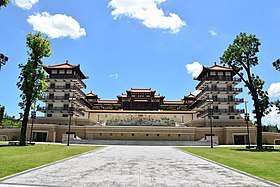
The educational programs of Fo Guang Shan include four Buddhist colleges, three regular colleges, and various community colleges. The Fo Guang University was established in 2000. It focuses mainly on the humanities and social sciences. The Chinese Buddhist research institute is subdivided into four separate departments; a women's and men's college, and an international and English Buddhist studies department. Tuition fees and lodging are provided by Fo Guang Shan, free of charge. Other prominent universities the order has established include Nanhua University in Taiwan and the University of the West in the United States.[7]
The organization also operates Pu-Men High School in Taipei, Jiun Tou Elementary and Junior High School, Humanities Primary and Junior High School, which provides regular curriculum for students. Fo Guang Shan also has nursery schools, kindergartens, and Sunday schools for children.
Along with Tzu Chi, Fo Guang Shan is the only major Buddhist organization in Taiwan that offers some form of strictly secular education, as opposed to purely religious.[6]
In mainland China, Fo Guang Shan operates numerous cultural education programs and has built several libraries, even having gotten several books published through state controlled media.[2][8]
Fo Guang Shan Buddha Museum
Building plans for the Fo Guang Shan Buddha Museum (formerly called the Buddha Memorial Center) started with support from the Taiwanese government. The museum's Jade Buddha Shrine is purported to hold tooth relics of the historic Buddha. The site is situated immediately adjacent to the main monastery and covers more than 100 hectares. The complex faces east and is built along a central axial line. Beyond the Welcoming Hall are eight Chinese-styled pagodas on either side of the main avenue leading up to the Bodhi Square, about which are statues of the Buddha's main disciples and of the founders of the principal schools of Chinese Buddhism. The path leads onto the Memorial Hall, which holds several shrines including the Jade Buddha Shrine. Above the hall are four stupas that symbolize the Four Noble Truths. Standing behind but separate from it, there is an enormous seated metal Shakyamuni Buddha 108 meters high.[9] The Center was opened at an international ceremony on 25 December 2011[10] and the first anniversary celebrated on Christmas Day 2012.[11]
Religious Affairs Committee
In 1972, Hsing Yun established a nine-member council, known as the Fo Guang Shan Religious Affairs Committee. These nine members govern the monastery and the order. The members are elected prior to the resignation, death, or the ending of a term of an abbot. Once elected by members of Fo Guang Shan, the votes are openly counted. The nine members then nominate their next abbot. Eight members of the council are ordained monastics, and one is a layperson.[12]
Abbots
Unlike a traditional Mahayana Buddhist monastery, where the incumbent abbot usually selects his successor, Fo Guang Shan directly elects an abbot to head the Order and its temple branches worldwide. The head of the FGS order and all of its branches is the abbot of Fo Guang Shan Monastery. The abbot is the chairperson of the Religious Affairs Committee, serving a term of six years, with one reappointment by popular vote and, under exceptional circumstances, a second reappointment by two-thirds vote. The abbot is elected by all members of Fo Guang Shan through public vote. The abbot-elect then begins to use their "inner name", in place of his/her own dharma name, with the first character being Hsin ("心", xin, or heart). In fact, all monastics of Fo Guang Shan have such a name, and several Elders also use theirs publicly. At the beginning of the year, the abbot-elect is inaugurated as the new director of Fo Guang Shan through a dharma transmission ceremony, receiving the robe and bowl.
Hsing Yun is the only abbot to have served as such for more than two terms, and was not elected by the RAC. In the case of Venerable Hsin Ping (who was originally Venerable Zhizong), he was also not officially elected, as he was Hsing Yun's designated heir apparent. After Hsin Ping died, the vice director of Fo Guang Shan, Hsin Ting (originally Venerable Zhidu), was immediately elevated to serve the remaining years of Hsin Ping's term. Abbots have been elected according to FGS's constitution since then.
As with Hsing Yun, former abbots do not leave the order when they retire. They continue to make Dharma talks throughout the world and become head teachers of the order in their later years.
Dharma propagation
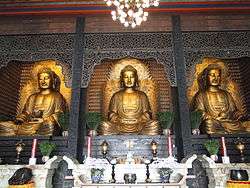
Dharma programs of Fo Guang Shan include lectures given in prisons and factories; programs on television and radio, large-scale public lectures in Taiwan and overseas, and the five precepts initiation given twice a year at the monastery.
All branches of Fo Guang Shan organize pilgrimages to bring devotees to the monastery from different parts of Taiwan and overseas.[13] Once pilgrims arrive, they are free to make use of all of the different activities that are open to the general public.
In mainland China, the order focuses on cultural exchange rather than religion as a way to introduce Buddhist ideas, as preaching is illegal in China.[2]
Fo Guang Shan's approach to Dharma propagation focuses on simplifying Buddhism in order to make it more appealing to the masses. The organization is known for utilizing modern marketing techniques and methods to preach such as the use of laser shows and multimedia displays.[2][6] Fo Guang Shan temples have no entrance fee, and do not allow many of the practices commonly found in other Chinese temples, such as fortune-telling or the presence of sales vendors.[2] Despite the popularity of the organization, Fo Guang Shan has received criticism for being "too focused on commercialism, expanding its membership base, and building large temples." (Schak and Hsiao)[6]
Objectives
- To propagate Buddhist teachings through cultural activities
- To foster talent through education
- To benefit society through charitable programs
- To purify human hearts and minds through Buddhist practice
Mottos
Official motto
May the Buddha's Light shine upon the ten directions. May the Dharma stream continuously flow towards the five great continents.
The Four Verses of Fo Guang Shan and BLIA
- May kindness, compassion, joy, and equanimity pervade all worlds;
- May we cherish and build affinities to benefit all beings;
- May Chan, Pure Land, and Precepts inspire equality and patience;
- May our humility and gratitude give rise to great vows.[14]
BLIA guidelines
- Offer others confidence
- Offer others joy
- Offer others hope
- Offer others convenience[15]
Abbots and directors
Branches
See also
References
- Harding, John S.; Hori, Victor Sōgen; Soucy, Alexander (29 March 2010). Wild Geese: Buddhism in Canada. McGill-Queen's Press – MQUP. p. 283. ISBN 9780773591080.
- Johnson, Ian (24 June 2017). "Is a Buddhist Group Changing China? Or Is China Changing It?". The New York Times. ISSN 0362-4331. Archived from the original on 31 January 2018. Retrieved 25 June 2017.
- "Come to Taiwan,Return with good memories". Info.taiwan.net.tw. Archived from the original on 27 February 2012. Retrieved 15 February 2012.
- Shuai, J. J.; Chen, H. C.; Chang, C. H. (1 December 2010). "Visualization of the Taiwaness Buddhism web based on social network analysis". 2010 International Computer Symposium (ICS2010): 187–191. doi:10.1109/COMPSYM.2010.5685523. ISBN 978-1-4244-7639-8.
- 2600 Years of Sambuddhatva: Global Journey of Awakening. 1 January 2011. p. 282. ISBN 9789559349334.
- Schak, David; Hsiao, Hsin-Huang Michael (1 June 2005). "Taiwan's Socially Engaged Buddhist Groups". China Perspectives. 2005 (59). doi:10.4000/chinaperspectives.2803. ISSN 1996-4617.
- Juergensmeyer, Mark; Roof, Wade Clark (2012). Encyclopedia of Global Religion. SAGE. p. 406. ISBN 9780761927297.
- Johnson, Ian; Wu, Adam (24 June 2017). "A Buddhist Leader on China's Spiritual Needs". The New York Times. ISSN 0362-4331. Archived from the original on 26 January 2018. Retrieved 25 June 2017.
- "佛光山佛陀紀念館". 佛光山佛陀紀念館. Archived from the original on 6 September 2017. Retrieved 6 September 2017.
- "Regional Interfaith report". Archived from the original on 10 April 2013. Retrieved 29 January 2013.
- Lovelock, Yann, A Buddhist Christmas Archived 16 October 2014 at the Wayback Machine
- "Fo Guang Shan Online Service". Archived from the original on 7 April 2006.
- "FGS Singapore". Fo Guang Shan (Singapore) & Buddha's Light Association (Singapore). Archived from the original on 22 December 2014. Retrieved 22 December 2014.
- http://fgsihb.org/dictionary-info.asp?id=19509
- "FGS Singapore". Archived from the original on 6 December 2015. Retrieved 22 December 2014.
Bibliography
- Chandler, Stuart (2002). Globalizing Chinese Culture, Localizing Buddhist Teachings: the Internationalization of Foguangshan, Journal of Global Buddhism 3, 46–78
- Chandler, Stuart (2004). Establishing a Pure Land on Earth: The Foguang Buddhist Perspective on Modernization and Globalization. Honolulu: University of Hawaii Press
